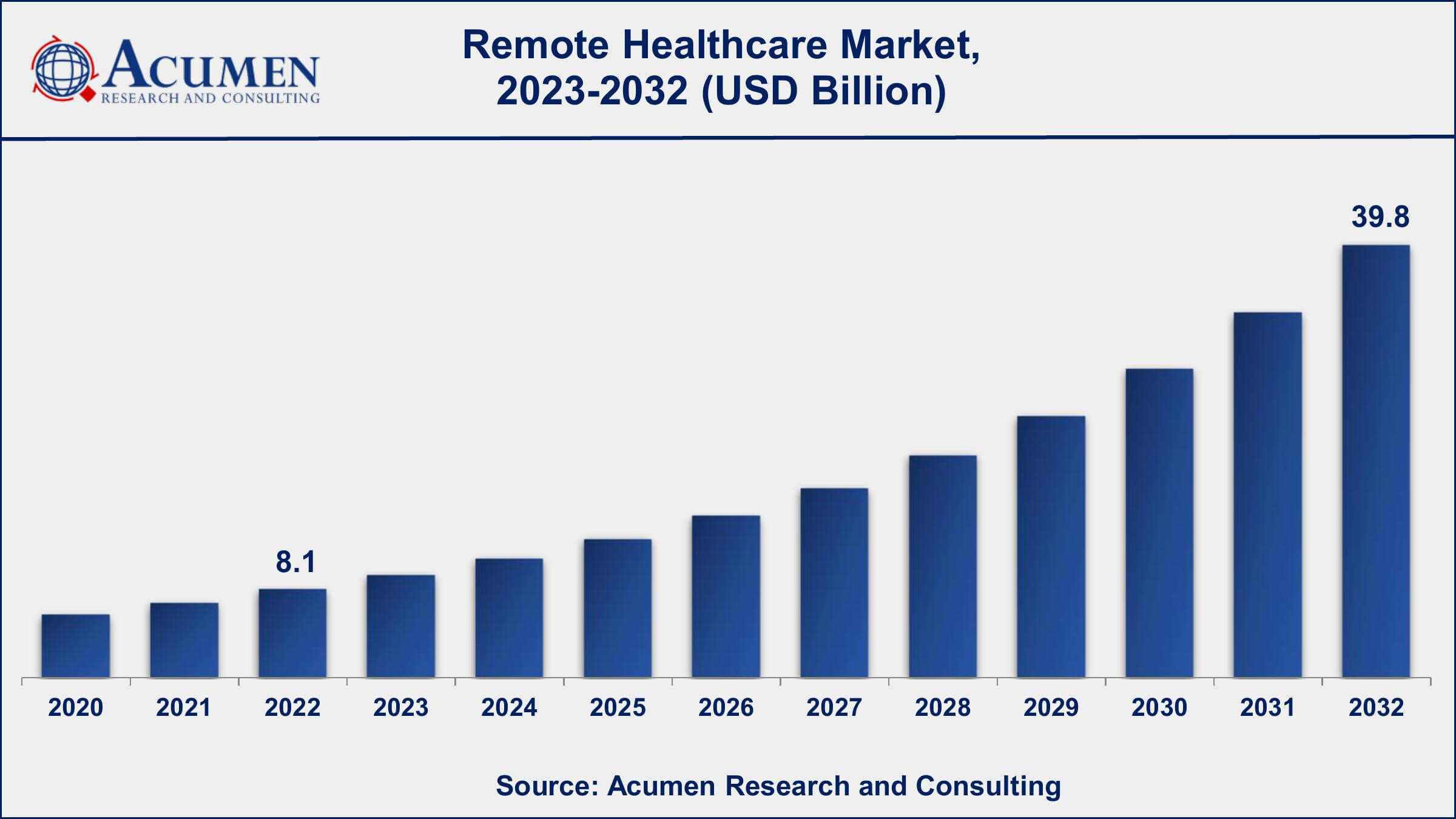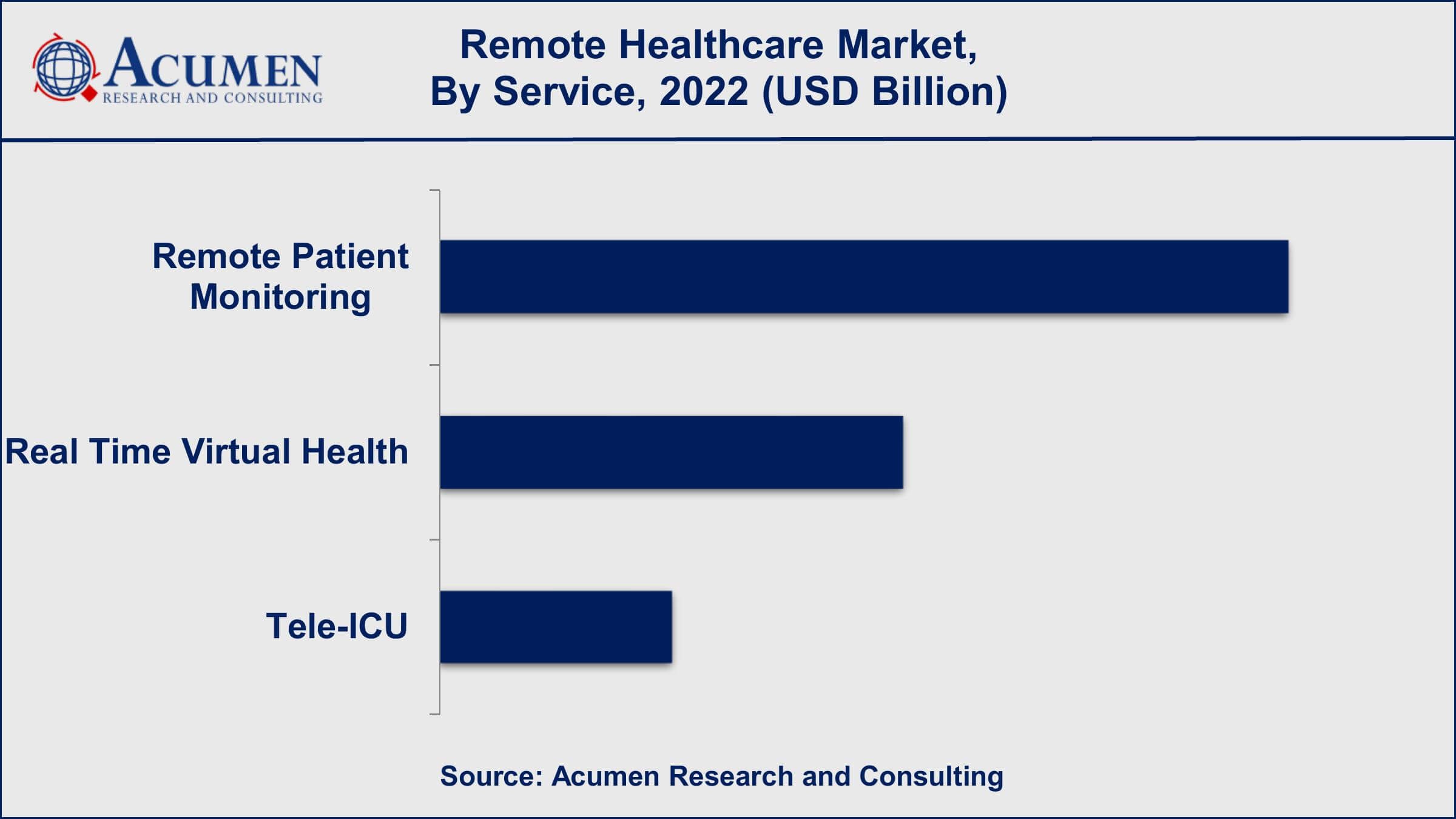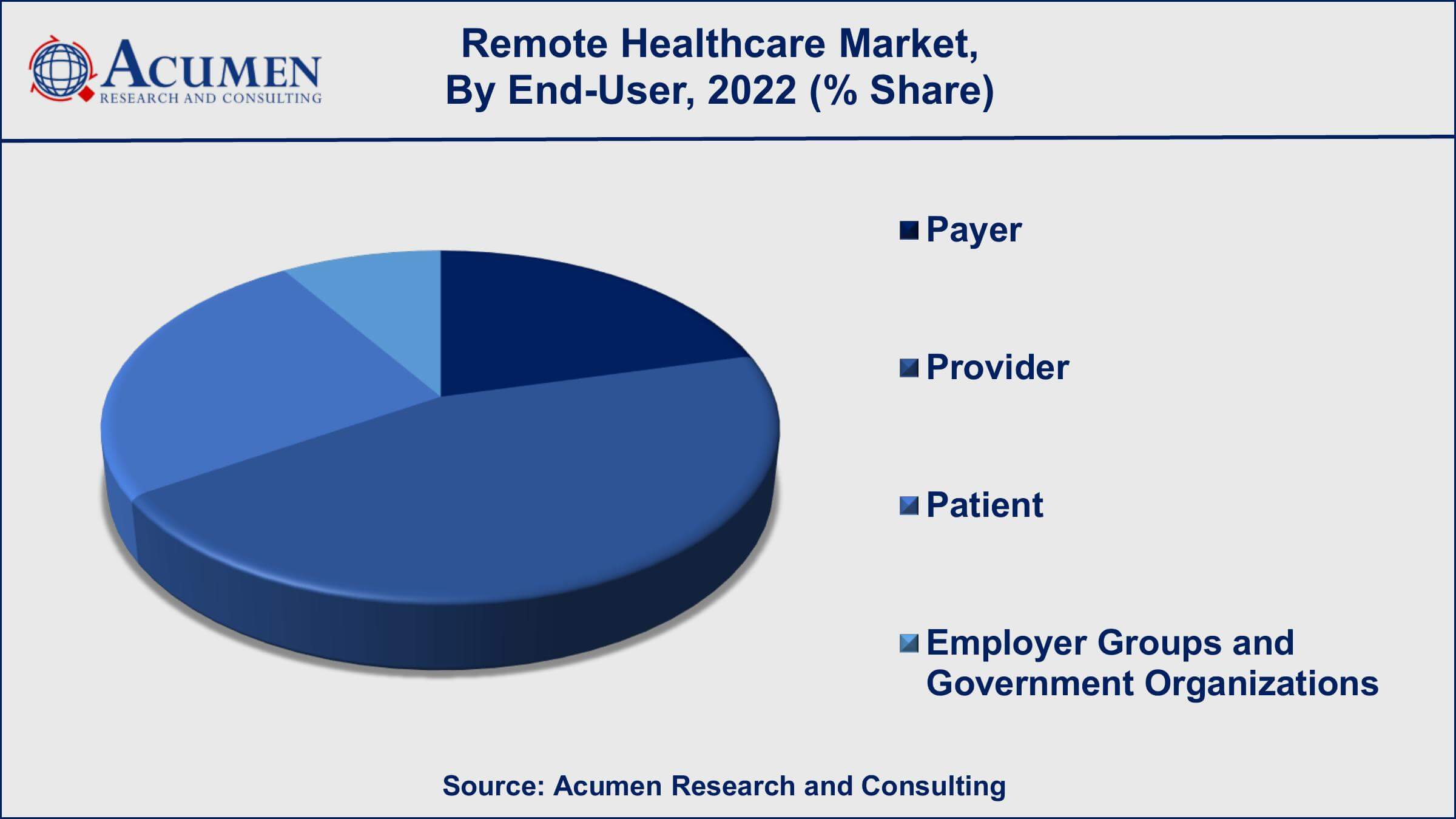Remote Healthcare Market Size - Global Industry, Share, Analysis, Trends and Forecast 2023 - 2032
Published :
Report ID:
Pages :
Format :
Remote Healthcare Market Size - Global Industry, Share, Analysis, Trends and Forecast 2023 - 2032
Report Coverage
- Industry Dynamics
- Market Size and Forecast Data
- Segment Analysis
- Competitive Landscape
- Regional Analysis with a Niche Focus on Country-Level Data
- High Level Analysis - Porter's, PESTEL, Value Chain, etc.
- Company Profiles of Key Players
- Option to Customize the Report As Per Your Specific Need
Request Sample Report
The global Remote Healthcare Market size was valued at USD 8.1 Billion in 2022 and is projected to attain USD 39.8 Billion by 2032 mounting at a CAGR of 17.4% from 2023 to 2032.
Remote Healthcare Market Highlights
- Global remote healthcare market revenue is poised to garner USD 39.8 billion by 2032 with a CAGR of 17.4% from 2023 to 2032
- North America remote healthcare market value occupied around USD 3.3 billion in 2022
- Asia-Pacific remote healthcare market growth will record a CAGR of more than 18% from 2023 to 2032
- Among service, the remote patient monitoring sub-segment occupied over US$ 4.5 billion revenue in 2022
- Based on end-user, the provider sub-segment gathered around 45% share in 2022
- Integrating telehealth into insurance plans is a popular remote healthcare market trend that drives the industry demand

Remote healthcare, often known as telehealth or telemedicine, is a method of providing medical treatments and support to patients from a distance using technology. This strategy connects healthcare specialists with patients via various digital tools and communication channels, allowing them to get medical advice, diagnoses, treatment suggestions, and even continuous care without the need for in-person visits to a healthcare institution.
Real-time video conferencing is an important component of remote healthcare because it allows patients to have face-to-face consultations with their healthcare professionals from the comfort of their own homes. This technology allows for a more direct and personalized engagement, allowing healthcare practitioners to examine patients’ ailments, discusses symptoms, and provides counsel remotely.
Remote healthcare may include various modes of contact in addition to video consultations, such as phone calls, text messaging, or encrypted messaging services. Depending on their preferences and the nature of their healthcare requirements, these alternatives give patients various options for medical advice and support.
Furthermore, remote healthcare goes beyond consultations, including remote monitoring of vital signs and chronic illnesses, prescription drug administration, and mental health counseling. Remote healthcare is becoming more integrated into the healthcare system as technology advances, providing patients with greater convenience and accessibility while also helping to address healthcare challenges such as improving access to care in rural or underserved areas while lowering the burden on healthcare facilities.

Global Remote Healthcare Market Dynamics
Market Drivers
- Enhanced medical accessibility
- Cost-effective healthcare solutions
- Improved patient convenience
- Mitigating provider shortages
- Chronic condition management support
Market Restraints
- Unequal digital access
- Regulatory hurdles
- Data security concerns
- Diagnostic limitations
Market Opportunities
- Advancing technology's potential
- Expanding global reach
- Growing demand for mental health services
- Home-based comprehensive care
Remote Healthcare Market Report Coverage
| Market | Remote Healthcare Market |
| Remote Healthcare Market Size 2022 | USD 8.1 Billion |
| Remote Healthcare Market Forecast 2032 | USD 39.8 Billion |
| Remote Healthcare Market CAGR During 2023 - 2032 | 17.4% |
| Remote Healthcare Market Analysis Period | 2020 - 2032 |
| Remote Healthcare Market Base Year | 2022 |
| Remote Healthcare Market Forecast Data | 2023 - 2032 |
| Segments Covered | By Service, By Application, By End-User, And By Geography |
| Regional Scope | North America, Europe, Asia Pacific, Latin America, and Middle East & Africa |
| Key Companies Profiled | AirStrip Technologies, Advanced ICU Care, American Well, BioTelemetry, InTouch Technologies, Koninklijke Philips, Medtronic, Resideo Life Care Solutions, Teladoc Health, Teva Pharmaceuticals, Inc., and Vivify Health. |
| Report Coverage |
Market Trends, Drivers, Restraints, Competitive Analysis, Player Profiling, Covid-19 Analysis, Regulation Analysis |
Remote Healthcare Market Insights
The remote healthcare industry is undergoing dynamic transitions as a result of a number of fundamental variables. For starters, the increased emphasis on accessibility and convenience is driving its growth. Patients, particularly in rural or disadvantaged regions, seek alternatives to get healthcare services without the difficulty of physically visiting healthcare institutions. This desire is met by remote healthcare, which offers virtual consultations, monitoring, and treatment choices, allowing patients to get medical care from the comfort of their own homes.
In addition, cost-effectiveness is a major motivator in the remote healthcare sector. Patients who choose remote consultations can save money on travel, parking, and time away from work. Furthermore, by incorporating telehealth services into their practice, healthcare professionals may optimize resource allocation and cut overhead expenses. Because of these cost-saving benefits, both patients and healthcare organizations have expanded their uptake.
However, there are significant constraints in the market. One such obstacle is the digital divide, which occurs when people have unequal access to technology and dependable internet services, which can limit the use of remote healthcare, especially in impoverished or rural places. Furthermore, regulatory complications and regional variances might provide challenges for healthcare providers wishing to offer telehealth services. Another significant constraint is data security, since protecting patient data and preserving privacy in a digital healthcare environment remains a high responsibility.
Despite these obstacles, the remote healthcare business offers exciting prospects. Technological advancements, such as artificial intelligence and remote monitoring equipment, are improving the quality and breadth of remote healthcare services. Telehealth's worldwide reach offers the ability to address global healthcare disparities by reaching underserved communities in diverse regions. Furthermore, there is an increasing need for mental health assistance via virtual consultations, which can broaden the scope of remote therapy. Furthermore, incorporating telemedicine into insurance plans can increase access to treatment, offering opportunity for both clinicians and patients.
To summarize, the remote healthcare industry is motivated by the need for accessibility, cost-effectiveness, and convenience, but it confronts obstacles relating to the digital divide, laws, and data security. However, technology improvements, worldwide accessibility, mental health services, home-based treatment, and insurance integration present intriguing potential for remote healthcare's future growth and development.
Remote Healthcare Market Segmentation
The worldwide market for remote healthcare is split based on service, application, end-user, and geography.
Remote Healthcare Services
- Remote Patient Monitoring
- Real Time Virtual Health
- Tele-ICU

According to the remote healthcare industry analysis, the remote patient monitoring sub-segment will have the most market share in 2022. Remote patient monitoring, which entails remotely recording patients' vital signs and health data, is especially important for treating chronic illnesses and providing ongoing care. This service has grown in popularity, particularly among people suffering from diabetes, hypertension, and heart disease.
Real-time virtual health consultations have also grown in popularity, particularly during the COVID-19 epidemic, since they allow consumers to communicate with healthcare providers for a variety of medical conditions without requiring in-person visits.
Tele-ICU services are specialised services that are frequently utilised in critical care settings to offer remote monitoring and assistance for intensive care units. While essential, tele-ICU services may be more limited in application than remote patient monitoring and real-time virtual health care.
Remote Healthcare Applications
- Diagnosis
- Cardiology
- Obstetrics
- Senior Care
- Others
Telemedicine and remote diagnosis have developed as critical components of the distant healthcare scene. These applications have received a lot of attention, especially during the COVID-19 epidemic. They provide a wide range of medical services, such as primary care consultations, specialist visits, and even mental health assistance, making them particularly useful in the context of remote healthcare delivery.
Remote monitoring has played an important role in delivering ongoing treatment to patients with cardiac problems in the field of cardiology. Real-time monitoring of vital signs, electrocardiogram (ECG) data, and other cardiac parameters might help patients by allowing healthcare practitioners to respond quickly when necessary.
Obstetrics has also experienced an increase in the use of remote healthcare applications. Pregnant women can use telehealth services to get prenatal care and check-ups, minimising the need for in-person appointments. This not only makes it easier for pregnant moms, but it also assures that they receive necessary treatment during their pregnancy.
Remote Healthcare End-Users
- Payer
- Provider
- Patient
- Employer Groups and Government Organizations

According to the remote healthcare market forecast, healthcare providers such as hospitals, clinics, and individual practitioners play a critical role in establishing and providing remote healthcare services to patients. Telemedicine and remote monitoring technology adoption inside healthcare provider organisations has been critical in extending access to remote healthcare. Healthcare payers, such as health insurance corporations and healthcare reimbursement organisations, have been key stakeholders in the development of remote healthcare services. They frequently advocate and promote the use of telehealth and remote monitoring as cost-effective and efficient methods of providing healthcare services.
Patients' voices are becoming increasingly important in the remote healthcare sector. Patient interest in telehealth and remote consultations has increased because to the increased need for quick and accessible healthcare services, particularly during the COVID-19 epidemic. Patients are pushing remote healthcare adoption by seeking out these services to satisfy their healthcare demands.
Employer groups and government agencies have both had a role in boosting remote healthcare use. Employers frequently include telehealth services in employee benefit packages, seeing the benefits of remote healthcare in keeping a healthy and productive workforce. Government organisations have also fostered the spread of remote healthcare services, particularly in underserved or rural regions, through legislative initiatives and financing.
Remote Healthcare Market Regional Segmentation
North America
- U.S.
- Canada
Europe
- U.K.
- Germany
- France
- Spain
- Rest of Europe
Asia-Pacific
- India
- Japan
- China
- Australia
- South Korea
- Rest of Asia-Pacific
Latin America
- Brazil
- Mexico
- Rest of Latin America
The Middle East & Africa
- South Africa
- GCC Countries
- Rest of the Middle East & Africa (ME&A)
Remote Healthcare Market Regional Analysis
North America, especially the United States, has been a pioneer in the use of remote healthcare technologies. Telemedicine and remote patient monitoring are becoming increasingly popular. A well-developed healthcare infrastructure, favorable reimbursement regulations, and a tech-savvy populace are all factors that contribute to this. The COVID-19 pandemic has boosted remote healthcare use, with legislative improvements making telehealth services more accessible.
Europe has seen significant expansion in remote healthcare services, owing to improved technical infrastructure and an emphasis on cost-effective healthcare delivery. Telemedicine is becoming more incorporated into healthcare systems, which benefits both patients and physicians. However, regulatory and privacy issues, as well as differences in healthcare policy among European nations, continue to have an influence on industry growth.
The Asia-Pacific region has showed tremendous promise for the growth of the remote healthcare industry. Telemedicine is rapidly expanding in countries such as China and India, owing to big populations and a dearth of healthcare experts in some locations. Growth has also been spurred by rising smartphone usage and government backing for digital health projects.
Remote Healthcare Market Players
Some of the top remote healthcare companies offered in our report includes AirStrip Technologies, Advanced ICU Care, American Well, BioTelemetry, InTouch Technologies, Koninklijke Philips, Medtronic, Resideo Life Care Solutions, Teladoc Health, Teva Pharmaceuticals, Inc., and Vivify Health.
Frequently Asked Questions
What was the size of the global remote healthcare market in 2022?
The size of remote healthcare market was USD 8.1 billion in 2022.
What is the remote healthcare market CAGR from 2023 to 2032?
The remote healthcare market CAGR during the analysis period of 2023 to 2032 is 17.4%.
Which are the key players in the remote healthcare market?
The key players operating in the global remote healthcare market are AirStrip Technologies, Advanced ICU Care, American Well, BioTelemetry, InTouch Technologies, Koninklijke Philips, Medtronic, Resideo Life Care Solutions, Teladoc Health, Teva Pharmaceuticals, Inc., and Vivify Health.
Which region dominated the global remote healthcare market share?
North America region held the dominating position in remote healthcare industry during the analysis period of 2023 to 2032.
Which region registered fastest CAGR from 2023 to 2032?
Asia-Pacific region exhibited fastest growing CAGR for market of remote healthcare during the analysis period of 2023 to 2032.
What are the current trends in the global remote healthcare industry?
The current trends and dynamics in the remote healthcare industry include enhanced medical accessibility, cost-effective healthcare solutions, and improved patient convenience.
Which service held the maximum share in 2022?
The remote patient monitoring service held the maximum share of the remote healthcare industry.


